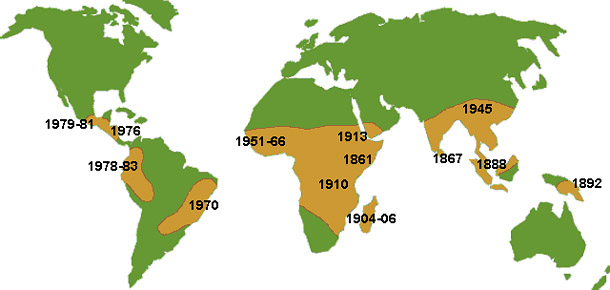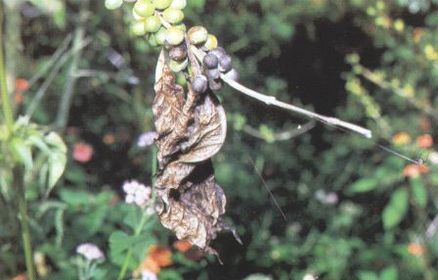Team:Colombia/Project/Problem
From 2012.igem.org
Template:Https://2012.igem.org/User:Tabima
Contents |
The Problem
The human and ecosystem problem
One of the main issues for the Colombian growers is the extensive use of fungicides and pesticides to control field epidemics. Fungicides have enormous potential to cause adverse effects in health, not only for growers but for consumers. Most fungicides currently in use are unlikely to cause frequent or severe systemic poisoning, most of them may be moderately irritating to skin and mucous membranes (EPA, 1999). Nonetheless chronic exposure can lead to serious adverse effects in health, like hepatocymegaly and malformations, specially in children and adolescents (Muri et al., 2009). Moreover fungicides and pesticides are usually found contaminating soils and waterbodies close to the crop fields and because of their low biodegradation they persist in the environment.
GMOs and the environment
The genetically modified organisms (GMO) are defined as living beings that carry foreign fragments of DNA in their genome; this DNA confers special features of human interest. Although these modifications imply large benefits for humans, we must consider that releasing GMOs to the environment can, and probably will, produce genetic disturbance in the natural populations reducing their genetic variability and affecting their evolutionary potential. In the case of bacteria, as in our system, the transference of genes is very common due to horizontal gene transfer, high growth rates and short life cycles.
Facing this issue, the Colombia Team @ iGEM proposes an innovative control method for the transfer of genetic information based on a toxin-antitoxin module.
Bacterial Wilt (Ralstonia solanacearum)
Ralstonia solanacearum attack almost 200 plant species in 33 different plant families. This constitutes one of the largest known host ranges for any plant pathogenic bacterium (Moorman BM., 2012). The disease it causes is known as Southern wilt, bacterial wilt, and brown rot of potato. Although Solanaceae (potato family) contains the greatest number of susceptible species, many other dicot and a few monocot plants are also susceptible. The important agricultural crops attack by this phytopathogen includes: Potato (Solanum tuberosum); Tomato (Lycopersicum esculentum); Aubergine (egg plant) (Solanum melongena); Banana, (Musa spp); Geranium (common name) (Pelargonium); Ginger (Zingiber officinale); Tobacco (Nicotiana tabacum); Sweet pepper (Capsicum spp); Olive (Olea europea) (USDA,2011). According to the USDA is considered an invasive organism and as there are no chemicals or biological agents that adequately control these bacteria. Infected plants MUST be discarded as soon as possible (Moorman B.M.,2012).
Engineering any type of solution against Ralstonia solanacearum carries enormous potential for our country. As a matter of fact, it is the cause of Moko (Liberato & Gasparotto, 2006), one of the two most important diseases of banana and plantain crops in Colombia (the other one being the fungal black sigatoka), causing in some fields near to 100% of losses (ICA,2003).
Coffee pathogens
Coffee is the most important agricultural product in international trade. Even a small reduction in coffee yields or a modest increase in production costs caused by the rust has a huge impact on the coffee producers, the support services, and even the banking systems in those countries whose economies are absolutely dependent on coffee export (Arneson, 2000).
Coffee rust
Coffee rust is the most economically important coffee disease in the world, and in monetary value. This fungus Hemileia vastatrix belongs to the class Basidiomycetes, the order Uredinales, and family Pucciniaceae. Even though it is capable of producing urediniospores and basidiospores, only the former infect the coffee plant while the latter have no known susceptible host. Urediniospores infect usually during rainy seasons, since germination requires a 24 to 48 hour continuous presence of free water (rain or heavy dew). Infection occurs over a wide range of temperature: from 15°C to 28°C with an optimum of 22°C, and only occurs through stomata on the underside of the leaf, so it does not form the pustules typical of many rusts. The infected leaves drop prematurely, which reduces photosynthetic capacity and weakens the plant (as seen in the following pictures), altogether reducing next season’s berry yield (as much as 10-fold) (Arneson, 2000).
Other pests:
The rust is not the only plague. Talking with coffee growers, they told us that there are new plagues that attack the coffee plants and even the resistant strains are attacked. A major problem is the "Pink disease". This fungus "Costicium salmonicolor"belongs to the class Basidiomycetes and according to the coffee growers is a disease that have been affecting the production in most parts of the country.
References
- Arneson, P. A. (2000). Coffee rust. The Plant Health Instructor. doi:10.1094/PHI-I-2000-0718-02
- EPA (1999). Fugicides. J. Routt Reigart and James R. Roberts(Eds.), Recognition and managment of Pesticides Poisonings (5th ed., pp. 138-155). Washington:EPA.
- [In spanish] CIAT. 2003. Memorias del Curso Manejo integrado de la enfermedad del Moko del pl·tano. CIAT, Cali, Junio 9 a 13 de 2003. 52 pp.
- Liberato JR & Gasparotto L (2006) Moko disease of banana (Ralstonia solanacearum ) Updated on 10/21/2011 9:31:50 AM Available online: PaDIL - http://www.padil.gov.au.
- Moorman B.M. (2012) Bacterial wilt-Ralstonia solanacearum. Penn State Extension: Plant disease fact sheets. Available on line at: http://extension.psu.edu/plant-disease-factsheets/all-fact-sheets/ralstonia
- Stefan D. Muri, Hilko van der Voet, Polly E. Boon, Jacob D. van Klaveren, Beat J. Brüschweiler. Comparison of human healthrisks resulting from exposure to fungicides and mycotoxins via food Food and Chemical Toxicology, Volume 47, Issue 12, December 2009, Pages 2963–2974
- USDA (2011) National Agricultural Library. Research; Special Note: NAL Catalog Search
 "
"



